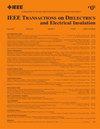Discharge Monitoring and Aging Assessment Method for Metallized Film Capacitor Based on Acoustic Signal
IF 2.9
3区 工程技术
Q2 ENGINEERING, ELECTRICAL & ELECTRONIC
IEEE Transactions on Dielectrics and Electrical Insulation
Pub Date : 2024-09-13
DOI:10.1109/TDEI.2024.3460733
引用次数: 0
Abstract
In modular multilevel converters (MMCs) of HVDC systems, metallized film capacitors (MFCs) are commonly used as dc-link capacitors. Based on the unique feature of the self-healing discharge, MFCs can clear internal defects and maintain operation stability. However, self-healing discharge can cause continuous aging of MFCs due to the accumulation of electrode area loss. Although electrical parameters are sufficiently investigated to monitor the operating states of MFCs, the correlation between discharge characteristics and aging states remains unclear based on these parameters. To address this issue, this article provides a novel perspective by proposing a discharge monitoring and aging assessment method based on the acoustic signal. First, an accelerated aging platform is established to obtain MFC samples in different aging degrees. Then, the acoustic signal and the pulse current signal of MFC samples are detected to demonstrate the feasibility of using acoustic signals as characteristic parameters. Furthermore, the processed discharge data are subject to cluster analysis to investigate the relationship between discharge statistic characteristics and the aging states of MFCs. The results indicate that the aging states of MFCs can be assessed using the frequency spectrum characteristics and the cluster ratio of acoustic signals, guiding future research on the monitoring methods of MFCs using nonelectrical parameters.基于声学信号的金属化薄膜电容器放电监测和老化评估方法
在高压直流系统的模块化多电平变换器(mmc)中,金属化薄膜电容器(mfc)是常用的直流链路电容器。基于其独特的自愈放电特性,mfc可以清除内部缺陷并保持运行稳定性。然而,由于电极面积损失的积累,自愈放电会导致mfc的持续老化。尽管对mfc的电气参数进行了充分的研究,以监测其工作状态,但基于这些参数,放电特性与老化状态之间的相关性尚不清楚。为了解决这一问题,本文提出了一种基于声信号的放电监测和老化评估方法。首先,建立加速老化平台,获取不同老化程度的MFC样品;然后,对MFC样品的声信号和脉冲电流信号进行检测,验证了以声信号作为特征参数的可行性。对处理后的放电数据进行聚类分析,探讨放电统计特征与mfc老化状态之间的关系。结果表明,利用声信号的频谱特性和聚类比可以对mfc的老化状态进行评估,指导了未来mfc非电参数监测方法的研究。
本文章由计算机程序翻译,如有差异,请以英文原文为准。
求助全文
约1分钟内获得全文
求助全文
来源期刊
CiteScore
6.00
自引率
22.60%
发文量
309
审稿时长
5.2 months
期刊介绍:
Topics that are concerned with dielectric phenomena and measurements, with development and characterization of gaseous, vacuum, liquid and solid electrical insulating materials and systems; and with utilization of these materials in circuits and systems under condition of use.

 求助内容:
求助内容: 应助结果提醒方式:
应助结果提醒方式:


